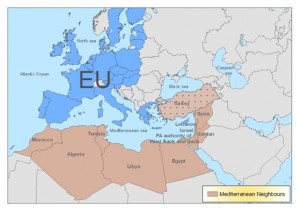In order to be able to have a deeper understanding of the Mediterranean diet, it would be good to know where it all started, where the Mediterranean foods, Mediterranean cuisine and Mediterranean diet started so as to understand the culture and driving forces of the area.
Below is the analysis of the third group of countries which comprise the Mediterranean group (the first two groups of countries were analyzed in the previous documents, Part 1 an Part 2 of this series):

Lebanon: Lebanon is a country in Western Asia on the Eastern shores of the Mediterranean Sea and it is at the crossroads of the Mediterranean Basin. Lebanon has a moderate Mediterranean climate especially along the coastal areas. The Lebanese cuisine includes all the components of the Mediterranean cuisine, as it includes fruits, vegetables, fresh fish, cheese and it very rarely has animal fats. Yogurt and humus are two basic components of the Mediterranean Lebanese cuisine. Mostly food is grilled and olive oil is either used to sauté the food or as an add-on to give it taste and flavour. Simple fresh fruits together with the well known Baklava desert accompany a Lebanese meal.
Israel: Israel is a Jewish state located on the Eastern shore of the Mediterranean Sea. Israel’s coastal areas enjoy the Mediterranean climate, with cool rainy winters and hot summers. The Israeli cuisine could not have been unaffected by the effects of the Mediterranean culture even though it has dishes that were brought into the country by the Jews who came from various parts of the world. The Israeli cuisine incorporates dishes that are traditional dishes of the Mediterranean cuisine such as humus and falafel plus seafood like squid (calamari).
Egypt: Egypt is another transcontinental country in the Mediterranean Sea, mainly located in North Africa with the Sinai Peninsula located in Asia. Egypt is bordered in the North by the Mediterranean Sea and thus its coastal areas enjoy the Mediterranean climate. The Egyptian cuisine makes heavy use of legumes and fresh vegetables, both basic components of the Mediterranean diet. Lentils and mashed fava beans are also popular dishes in Egypt. Almonds and other nuts along with semolina, made from durum wheat, are basic components of Egyptian deserts.
Libya: Libya is a country in North Africa bordering the Mediterranean Sea in the North thus these areas enjoy the benefits of the Mediterranean climate. The Libyan cuisine has 4 basic components, olives and olive oil, palm dates, grains and Milk, 3 of which, olives, grains and milk, are basic components of the Mediterranean cuisine. In sweets several types of nuts are used as basic components enriching the Mediterranean dietary needs of the Libyans.
Tunisia: Tunisia is the northernmost country of Africa and at north and east is bordered by the Mediterranean Sea. Tunisia’s climate in the North is Mediterranean type. The Tunisian cuisine is a blend of the Mediterranean cuisine and the type of cooking the desert people follow. Like in all the countries of the Mediterranean the Tunisian cuisine and dietary habits revolve around olives and olive oil, seafood, fresh vegetables and dairy products.
Algeria: Algeria is a country in North Africa and the largest Mediterranean county in terms of land. It is bordered in the North by the Mediterranean Sea and thus Northern Algeria is in the temperate zone and thus enjoys a mild Mediterranean climate. The Algerian cuisine is a fusion of the Middle Eastern cuisine with the Mediterranean cuisine and differs slightly from region to region within Algeria. The basic components of the Algerian cuisine in the Northern Mediterranean region are: fresh fruits, vegetables, fish and seafood, all of which are in the Mediterranean pyramid. The desserts in Algeria are simple made of basic ingredients like the popular Asida, a desert made of wheat.
Morocco: Morocco is a country located in North Africa with shores in both the Mediterranean Sea in the North and the Atlantic Ocean in the west. The climate in the North is Mediterranean. The Moroccan cuisine is probably one of the most diversified cuisines of the world with influences from many civilizations and nations. It has influences, among others, from the Mediterranean cuisine. The Moroccan cuisine uses, mint, olives, oranges and lemons and chicken. The most popular Moroccan dish is the couscous made with semolina wheat and finely ground wheat four.
With the completion of the third article about the countries ‘’blessed by God’’ to be part of the Mediterranean basin and have their shores to ‘’touch’’ the Mediterranean cuisine.














{ 0 comments… add one now }